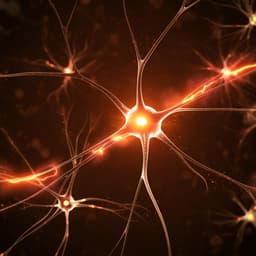
Medicine and Health
Association of greenspace and natural environment with brain volumes mediated by lifestyle and biomarkers among urban residents
X. Shang, W. Wang, et al.
Living nearer greenspace and natural environments was associated with larger total, grey and white matter brain volumes in 34,454 UK Biobank participants; smoking and physical activity—and biomarkers including vitamin D, red blood cell indices and creatinine—partly mediated these links. This research was conducted by the authors listed in Authors.
~3 min • Beginner • English
Introduction
The study addresses the need to identify determinants of brain atrophy and dementia risk beyond traditional vascular and metabolic factors, which explain only a small fraction of variance in brain volumes. Prior research links environmental exposures such as greenspace and air pollution to physical and mental health outcomes, and limited studies suggest potential relationships with brain structure; however, findings on greenspace and brain volumes are inconsistent and mechanisms unclear. This study investigates whether residential greenspace and natural environment coverage are associated with brain volumes in urban residents and whether lifestyle factors and biomarkers mediate these associations, providing evidence relevant to urban planning for brain health.
Literature Review
Evidence indicates greenspace is associated with lower depression risk and better cognitive health (UK Biobank and Nurses' Health Study II). Two imaging studies with smaller samples reported mixed results: one found increased greenspace associated with greater cortical thickness in parietal and occipital regions among urban adults, while another found no significant association with brain volume in older non-demented adults. Pathway analyses in prior work suggest physical activity, air pollution, and social interaction may mediate greenspace–mental health links. The literature lacks comprehensive evaluation of lifestyle and biomarker mediators between greenspace/natural environment and brain volumes, motivating this study.
Methodology
Design and cohort: Prospective analysis within the UK Biobank cohort (baseline 2006–2010; >500,000 adults aged ≥40 years). MRI imaging occurred 2014–2019. Ethical approvals obtained; informed consent provided. Sample selection: Excluded participants without MRI (n=462,809), with neurological disorders (n=1,799), or living in rural areas (n=3,443), resulting in 34,454 urban participants (53.4% female; baseline age mean±SD 54.7±7.5 years; MRI age 63.5±7.6 years). Brain MRI: Siemens Skyra 3T; T1/T2 analyzed with FSL. Brain volumes included total brain (grey+white matter), grey matter, white matter; white matter hyperintensity (WMH) volume log-transformed. Volumes normalized for head size (ratio-corrected) and standardized (mean 0, SD 1). Higher total, grey, white matter and lower WMH indicate better brain health. Environment measures: Residential greenspace from 2005 Generalized Land Use Database; coverage percentage within 300 m and 1000 m circular buffers computed via area-weighted means. Natural environment percentage from Land Cover Map 2007 (classes 1–21 as natural, 22–23 built) within 300 m and 1000 m buffers. Air pollution: Annual PM2.5 at baseline from SAHSU linked to participants; included as covariate. Genetics: Genotyping via UK BiLEVE/UK Biobank Axiom arrays; APOE4 status from rs7412/rs429358 (dominant model E2/E4, E3/E4, E4/E4). Demographics and lifestyle: Self-reported age, sex, ethnicity, education, income; neighborhood deprivation via Townsend index. Lifestyle: diet (seven food groups healthy diet score), smoking status, sleep duration, alcohol frequency, and physical activity (IPAQ short form). Biomarkers: Blood lipids (total cholesterol, HDL-C, LDL-C, triglycerides), HbA1c, vitamin D, creatinine, insulin-like growth factor 1, red blood cell indices (e.g., mean corpuscular volume [MCV], mean sphered cell volume [MSCV], mean reticulocyte volume [MRV], immature reticulocyte fraction [IRF], red blood cell count), and other serum analytes; urinary sodium, potassium, microalbumin, creatinine. Multimorbidity risk score: Derived from 33 chronic diseases previously associated with brain volumes, calculated as Σβᵢ×Dᵢ. Statistical analysis: Baseline characteristics summarized by greenspace quintiles (ANOVA, chi-square). Primary associations tested using general linear regression across four models: Model 1 (age, sex); Model 2 (Model 1 + ethnicity, education, income, Townsend); Model 3 (Model 2 + smoking, physical activity, diet score, alcohol, sleep, BMI, vitamin D, APOE4, multimorbidity score); Model 4 (Model 3 + PM2.5). Greenspace/natural environment analyzed in quintiles and continuously (per 10% increase). Mediation analysis: Tested individual and combined mediators using criteria: mediator associated with exposure; exposure associated with brain volume; mediator associated with brain volume; and attenuation of exposure–outcome association upon mediator adjustment. Candidate mediators: 71 variables across lifestyle (n=15), health conditions (n=3), blood biomarkers (n=49), urinary biomarkers (n=4). False discovery rate controlled at 5% (Benjamini–Hochberg). Effect modification: Tested by age, sex, education, Townsend index via interaction terms. Sensitivity: Inverse probability weighting (IPWM) to address potential selection due to MRI availability. Missing data: Multiple imputation (five datasets) for physical activity, income, education, BMI, smoking including age, sex, and all covariates.
Key Findings
- Sample: 34,454 urban participants; those with higher greenspace tended to be older, white, more physically active, never-smokers, with lower education and income; higher greenspace associated with lower PM2.5. - Associations with brain volumes: Greenspace (1000 m) per 10% increase associated with larger volumes: total brain β=0.013 (95% CI 0.005–0.020), grey matter β=0.013 (0.006–0.020), white matter β=0.011 (0.004–0.017) after full adjustment (including PM2.5). Quintile 5 vs 1: total brain 0.07 (0.03–0.11), grey 0.07 (0.03–0.11), white 0.06 (0.03–0.10). Greenspace (300 m) showed similar effects (e.g., per 10%: total 0.013 (0.006–0.019), grey 0.010 (0.004–0.016), white 0.011 (0.005–0.017)). - Natural environment (1000 m) per 10% associated with larger volumes: total brain β=0.010 (0.004–0.017), grey β=0.009 (0.004–0.015), white β=0.010 (0.004–0.016). Quintile 5 vs 1: total 0.06 (0.02–0.11), grey 0.07 (0.03–0.10), white 0.05 (0.01–0.09). Similar results for 300 m buffers. - WMH: No significant associations with greenspace or natural environment across models. - Biomarkers by exposure: Highest greenspace quintile (1000 m) had higher vitamin D and urea; lower MCV, MSCV, MRV, IRF, and urinary creatinine versus lowest quintile; similar patterns for other buffers/exposures. - Lifestyle/biomarkers and brain volumes: Former and current smokers had smaller total and grey matter volumes; higher physical activity associated with larger total brain volume; higher vitamin D associated with larger total, grey, and white matter volumes. - Mediation (greenspace 1000 m → total brain): 12 of 71 factors significant after FDR. Leading mediators: smoking 7.9% (95% CI 5.5–11.4), MSCV 3.3% (1.8–5.8), vitamin D 2.9% (1.6–5.1), blood creatinine 2.7% (1.6–4.7). Combined mediators explained 18.5% (13.2–25.3) of the association. - Mediation (greenspace 1000 m → grey matter): smoking 15.8% (5.8–22.9), MSCV 6.6% (4.0–10.5), vitamin D 4.6% (2.7–7.8), blood creatinine 4.3% (2.5–7.2), MCV 3.0% (1.6–5.5), IRF 2.9% (1.5–5.7); combined 32.9% (22.3–45.7). - Mediation (natural environment 1000 m → total brain): leading mediators smoking 9.0% (6.2–12.8), vitamin D 3.7% (2.1–6.6), MSCV 3.1% (1.7–5.5), blood creatinine 2.6% (1.5–4.5), urea 2.3% (1.3–4.1); combined 20.6% (14.7–28.1). For grey matter, combined 38.4% (25.6–53.1). - Effect modification: Associations with total brain and white matter volumes were stronger in older (≥65 years) versus younger (<65 years) individuals; no significant interactions for sex, education, or deprivation. - Sensitivity (IPWM): Results consistent with main analyses for both buffer sizes and exposures.
Discussion
The study demonstrates that greater residential coverage of greenspace and natural environment is associated with larger total, grey, and white matter volumes, independent of demographic factors, socioeconomic status, lifestyle, multimorbidity, APOE4, vitamin D, BMI, and air pollution. The lack of association with WMH suggests effects may be more pronounced in tissue volumes than in small-vessel disease markers. Mediation analyses indicate that reductions in smoking and increases in physical activity partially explain these associations, along with biomarker pathways involving higher vitamin D levels and favorable red blood cell indices (lower MSCV/MCV/MRV/IRF) and renal-related markers (creatinine, urea). These pathways collectively accounted for roughly one-fifth of the association with total brain volume and about one-third to two-fifths for grey matter, highlighting plausible behavioral and physiological mechanisms. Stronger associations in older adults suggest potential age-related vulnerability or greater opportunity for greenspace-related benefits via slower atrophy rates. Findings align with prior evidence linking greenspace to mental and cardiometabolic health and extend it by identifying specific mediators connected to brain structure. The independence from PM2.5 adjustment implies benefits beyond air quality improvements, pointing toward lifestyle engagement and biomarker changes as key avenues.
Conclusion
Greater proximity to greenspace and natural environment is associated with better brain structural health (larger total, grey, and white matter volumes), particularly in older adults. Smoking, vitamin D, red blood cell indices (e.g., MSCV/MCV), creatinine, urea, and physical activity collectively mediate a substantive portion of these associations. Urban planning and design that increase access to greenspace and natural environments may promote brain health via behavioral and biomarker pathways. Future research should include longitudinal imaging to assess trajectories of brain change, incorporate address history and environmental changes over time, apply causal inference methods, and recruit more diverse populations to enhance generalizability.
Limitations
- Causality cannot be established; baseline MRI was unavailable, preventing analysis of brain volume changes and temporal mediation. - Potential selection bias due to inclusion of participants with MRI; however, IPWM sensitivity analyses were consistent. - No data on residential duration or prior addresses, which may introduce exposure misclassification. - Lifestyle and environmental changes between baseline and MRI could not be accounted for. - Predominantly European ancestry limits generalizability to other ethnic groups.
Related Publications
Explore these studies to deepen your understanding of the subject.







